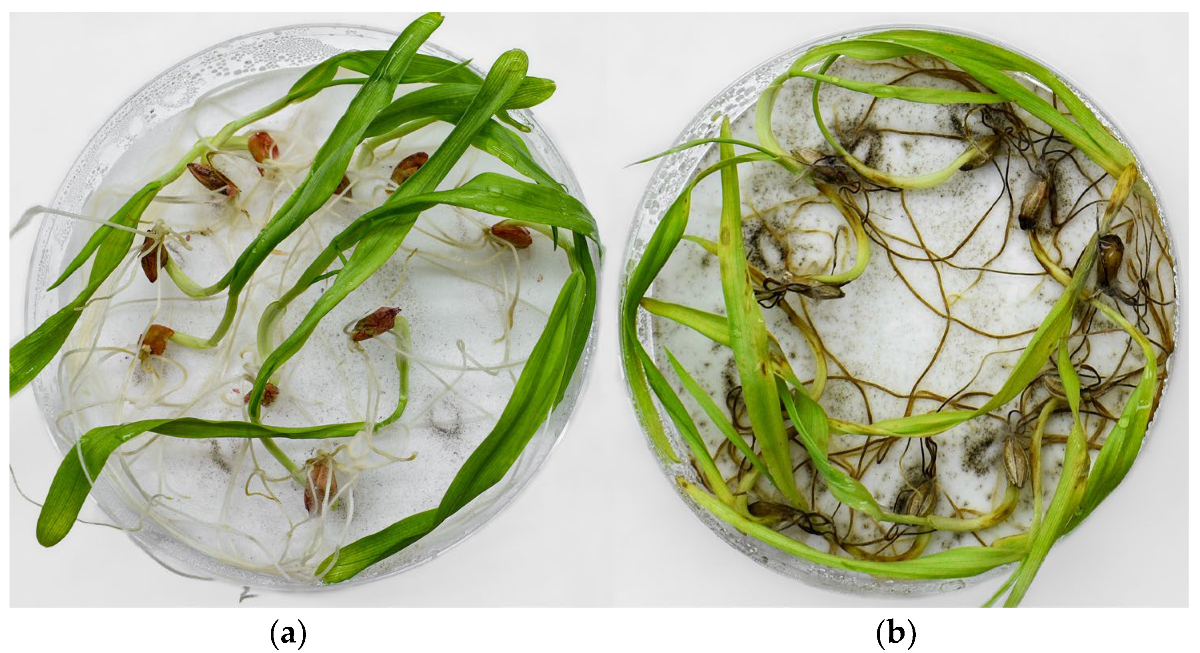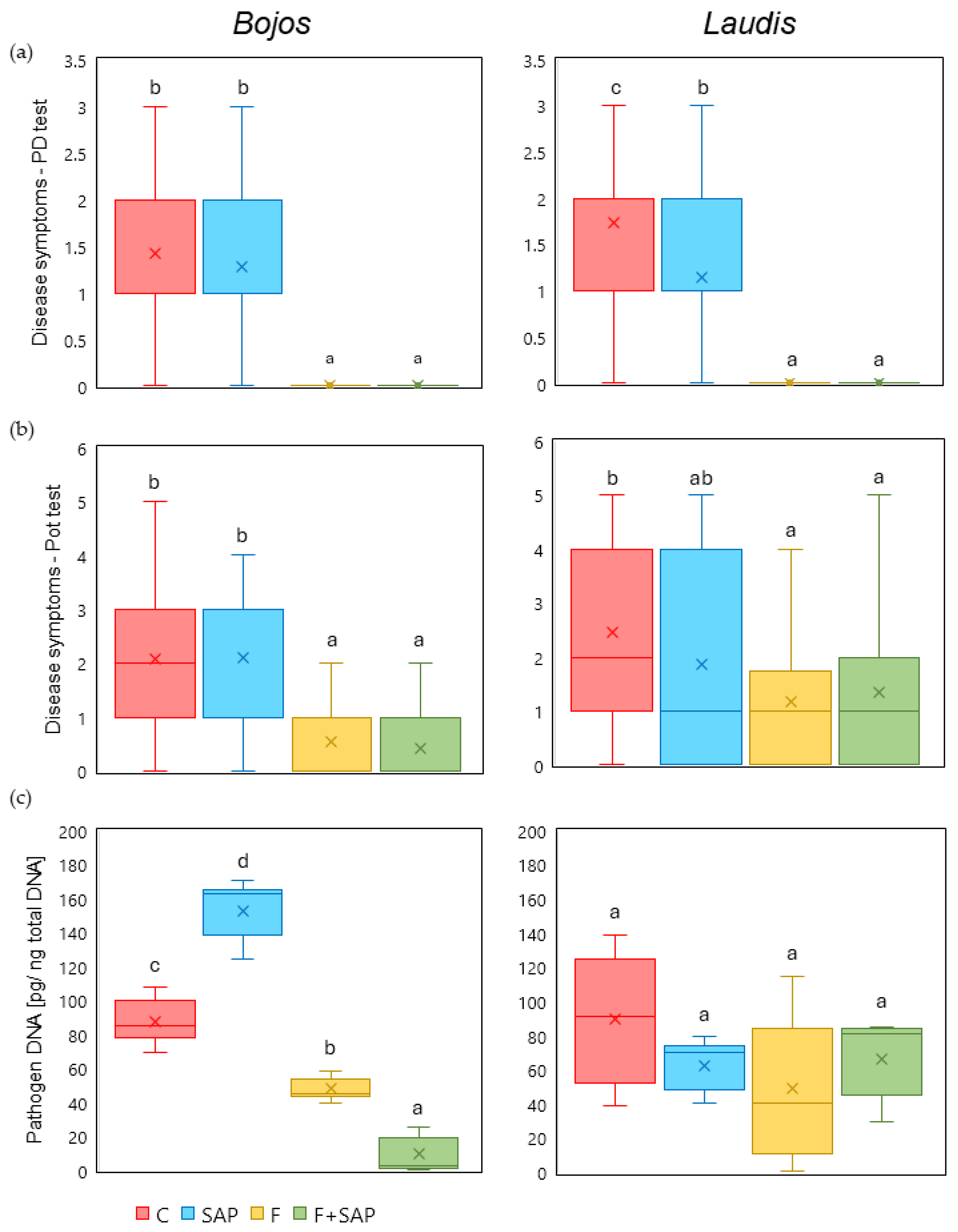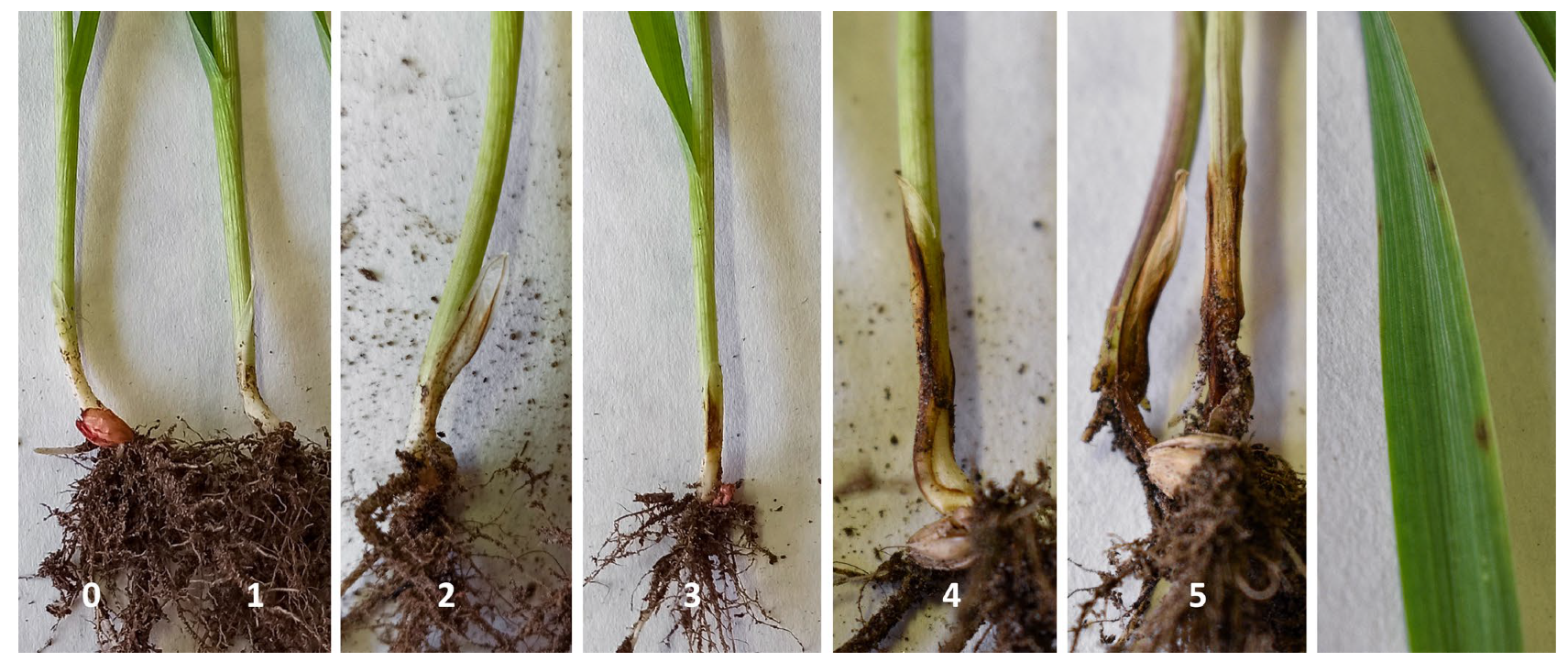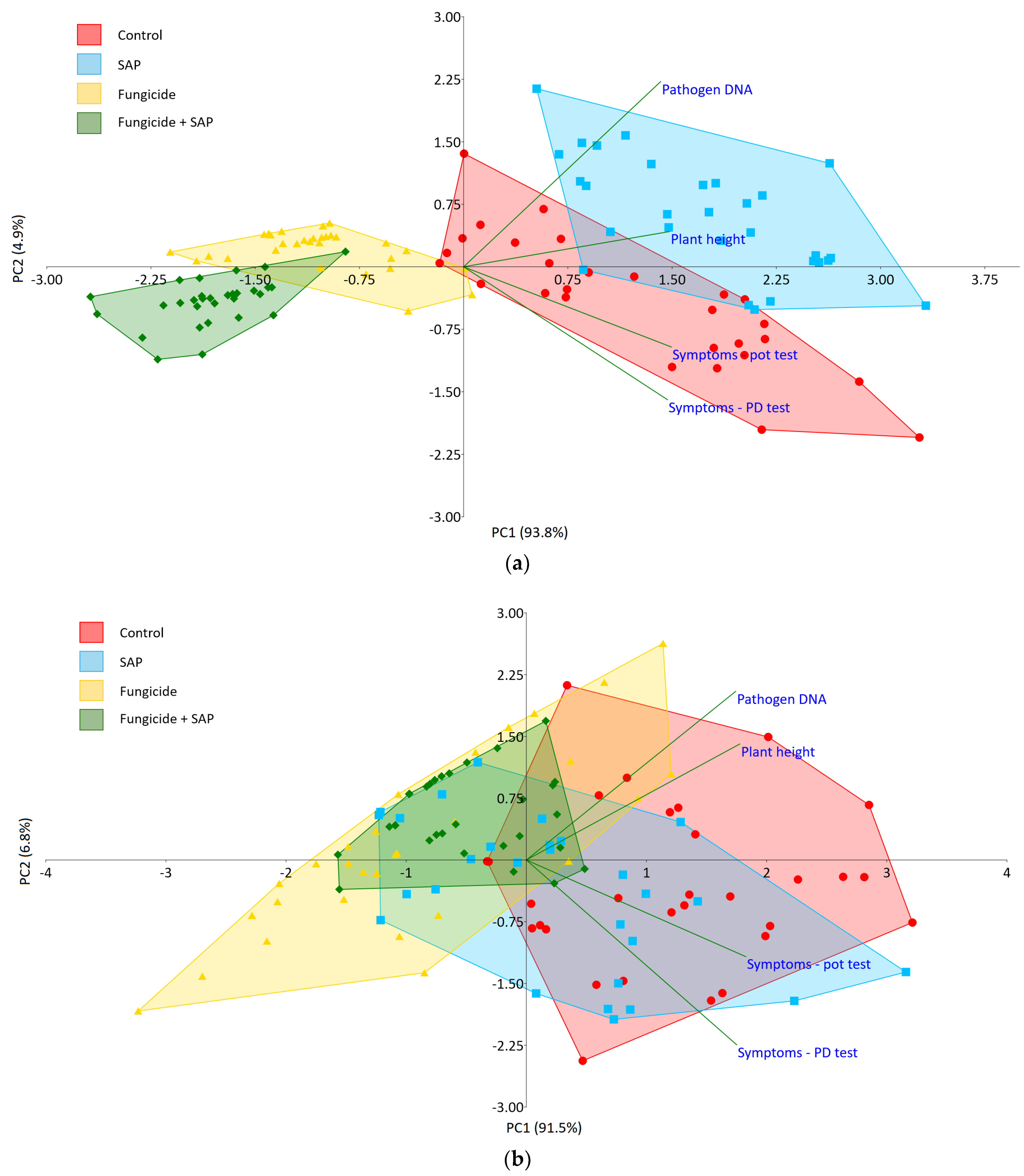Superabsorbent Seed Coating and Its Impact on Fungicide Efficacy in a Combined Treatment of Barley Seeds
Abstract
:1. Introduction
2. Materials and Methods
2.1. Biological Material
- C—control untreated seeds;
- SAP—polymer-treated seeds;
- F—fungicide-treated seeds;
- F + SAP—combined treatment of fungicides and SAP.
2.2. Petri Dish Test for Germination of Infected Seeds and Manifestation of Disease Symptoms
2.3. Pot Test for Plant Growth under Pathogen Attack and Disease Development
2.4. Statistical Analysis
3. Results
3.1. Petri Dish Test for Germination of Infected Seeds and Manifestation of Disease Symptoms
3.2. Pot Test for Plant Growth under Pathogen Attack and Disease Development
4. Discussion
5. Conclusions
Author Contributions
Funding
Institutional Review Board Statement
Data Availability Statement
Conflicts of Interest
References
- Oladosu, Y.; Rafii, M.Y.; Arolu, F.; Chukwu, S.C.; Salisu, M.A.; Fagbohun, I.K.; Muftaudeen, T.K.; Swaray, S.; Haliru, B.S. Superabsorbent Polymer Hydrogels for Sustainable Agriculture: A Review. Horticulturae 2022, 8, 605. [Google Scholar] [CrossRef]
- Cerasola, V.A.; Perlotti, L.; Pennisi, G.; Orsini, F.; Gianquinto, G. Potential Use of Superabsorbent Polymer on Drought-Stressed Processing Tomato (Solanum lycopersicum L.) in a Mediterranean Climate. Horticulturae 2022, 8, 718. [Google Scholar] [CrossRef]
- Kaur, P.; Agrawal, R.; Pfeffer, F.M.; Williams, R.; Bohidar, H.B. Hydrogels in agriculture: Prospects and challenges. J. Polym. Environ. 2023, 31, 3701–3718. [Google Scholar] [CrossRef]
- Malik, S.; Chaudhary, K.; Malik, A.; Punia, H.; Sewhag, M.; Berkesia, N.; Nagora, M.; Kalia, S.; Malik, K.; Kumar, D.; et al. Superabsorbent Polymers as a Soil Amendment for Increasing Agriculture Production with Reducing Water Losses under Water Stress Condition. Polymers 2023, 15, 161. [Google Scholar] [CrossRef] [PubMed]
- Zheng, H.; Mei, P.; Wang, W.; Yin, Y.; Li, H.; Zheng, M.; Ou, X.; Cui, Z. Effects of super absorbent polymer on crop yield, water productivity and soil properties: A global meta-analysis. Agric. Water Manag. 2023, 282, 108290. [Google Scholar] [CrossRef]
- Elshafie, H.S.; Camele, I. Applications of Absorbent Polymers for Sustainable Plant Protection and Crop Yield. Sustainability 2021, 13, 3253. [Google Scholar] [CrossRef]
- Guan, Y.; Cui, H.; Ma, W.; Zheng, Y.; Tian, Y.; Hu, J. An enhanced drought-tolerant method using SA-loaded PAMPS polymer materials applied on tobacco pelleted seeds. Sci. World J. 2014, 2014, 752658. [Google Scholar] [CrossRef] [PubMed]
- Kumar, S.V.; Vyakaranahal, B.; Deshpande, V.; Raikar, S.; Nadaf, H.; Kumar, B.A. Effect of seed polymer coating on growth and yield of pigeonpea. Karnataka J. Agric. Sci. 2014, 27, 469–471. [Google Scholar]
- Su, L.; Li, J.; Xue, H.; Wang, X. Super absorbent polymer seed coatings promote seed germination and seedling growth of Caragana korshinskii in drought. J. Zhejiang Univ.-Sci. B 2017, 18, 696–706. [Google Scholar] [CrossRef]
- Ovalesha, M.A.; Yadav, B.; Rai, P.K. Effects of polymer seed coating and seed treatment on plant growth, seed yield and quality of Cowpea (Vigna unguiculata). J. Pharmacogn. Phytochem. 2017, 6, 106–109. [Google Scholar]
- Pathak, V.; Ambrose, R.P.K. Starch-based biodegradable hydrogel as seed coating for corn to improve early growth under water shortage. J. Appl. Polym. Sci. 2020, 137, 48523. [Google Scholar] [CrossRef]
- Jarecki, W.; Wietecha, J. Effect of seed coating on the yield of soybean Glycine max (L.) Merr. Plant Soil Environ. 2021, 67, 468–473. [Google Scholar] [CrossRef]
- Pačuta, V.; Rašovský, M.; Michalska-Klimczak, B.; Wyszyňski, Z. Impact of Superabsorbent Polymers and Variety on Yield, Quality and Physiological Parameters of the Sugar Beet (Beta vulgaris prov. Altissima Doell). Plants 2021, 10, 757. [Google Scholar] [CrossRef] [PubMed]
- Fagundes, L.K.; Nunes, U.R.; Prestes, O.D.; Fernandes, T.S.; Ludwig, E.J.; Saibt, N. Rice seed treatment and recoating with polymers: Physiological quality and retention of chemical products. Rev. Caatinga 2017, 30, 920–927. [Google Scholar] [CrossRef]
- Park, W.-P.; Chang, K.-M.; Hyun, H.-N.; Boo, K.-H.; Koo, B.-J. Sorption and leaching characteristics of pesticides in volcanic ash soils of Jeju Island, Korea. Appl. Biol. Chem. 2020, 63, 71. [Google Scholar] [CrossRef]
- Ren, X.X.; Chen, C.; Ye, Z.H.; Su, X.Y.; Xiao, J.J.; Liao, M.; Cao, H.Q. Development and application of seed coating agent for the control of major soil-borne diseases infecting wheat. Agronomy 2019, 9, 413. [Google Scholar] [CrossRef]
- Chi, Y.; Ye, Z.; Su, X.; Li, Z.; Ren, X. Fabrication and applications of a microencapsulated prothioconazole based on β-cyclodextrin. Appl. Nanosci. 2022, 12, 2683–2693. [Google Scholar] [CrossRef]
- Gubišová, M.; Hudcovicová, M.; Matušinský, P.; Ondreičková, K.; Klčová, L.; Gubiš, J. Superabsorbent Polymer Seed Coating Reduces Leaching of Fungicide but Does Not Alter Their Effectiveness in Suppressing Pathogen Infestation. Polymers 2022, 14, 76. [Google Scholar] [CrossRef] [PubMed]
- Ondreičková, K.; Hrčková, K.; Klčová, L.; Cilík, P.; Gubiš, J. Superabsorbent polymer and its effect on maize germination, emergence and genetic diversity of rhizosphere microorganisms. Agriculture (Pol’nohospodárstvo) 2023, 69, 77–90. [Google Scholar] [CrossRef]
- Kumar, J.; Schäfer, P.; Hückelhoven, R.; Langen, G.; Baltruschat, H.; Stein, E.; Nagarajan, S.; Kogel, K. Bipolaris sorokiniana, a cereal pathogen of global concern: Cytological and molecular approaches towards better control. Mol. Plant Pathol. 2002, 3, 185–195. [Google Scholar] [CrossRef]
- Matusinsky, P.; Frei, P.; Mikolasova, R.; Svacinova, I.; Tvaruzek, L.; Spitzer, T. Species-specific detection of Bipolaris sorokiniana from wheat and barley tissues. Crop Prot. 2010, 29, 1325–1330. [Google Scholar] [CrossRef]
- Arabi, M.I.; Jawhar, M. A rapid technique for determining common root rot reaction in barley. Plant Breed. 1999, 118, 278–280. [Google Scholar] [CrossRef]
- Hammer, Ø.; Harper, D.A.; Ryan, P.D. PAST: Paleontological statistics software package for education and data analysis. Palaeontol. Electron. 2001, 4, 9. [Google Scholar]
- Kosiada, T. Influence of Ascochyta, Bipolaris, Drechslera, Fusarium inoculations on the germination, emergence and infection of barley leaves. Cereal Res. Commun. 2013, 41, 116–125. [Google Scholar] [CrossRef]
- Saad, A.; Macdonald, B.; Martin, A.; Knight, N.L.; Percy, C. Comparison of disease severity caused by four soil-borne pathogens in winter cereal seedlings. Crop Pasture Sci. 2001, 72, 325–334. [Google Scholar] [CrossRef]
- Koch, E.; Zink, P.; Pfeiffer, T.; von Galen, A.; Linkies, A.; Drechsel, J.; Birr, T. Artificial inoculation methods for testing microorganisms as control agents of seed- and soil-borne Fusarium-seedling blight of maize. J. Plant Dis. Prot. 2020, 127, 883–893. [Google Scholar] [CrossRef]
- Luchi, N.; Ioos, R.; Santini, A. Fast and reliable molecular methods to detect fungal pathogens in woody plants. Appl. Microbiol. Biotechnol. 2020, 104, 2453–2468. [Google Scholar] [CrossRef] [PubMed]
- Ekebafe, L.O.; Ogbeifun, D.E.; Okieimen, F.E. Polymer applications in agriculture. Biokemistri 2011, 23, 81–89. [Google Scholar]
- Milani, P.; França, D.; Balieiro, A.G.; Faez, R. Polymers and its applications in agriculture. Polímeros 2017, 27, 256–266. [Google Scholar] [CrossRef]
- Sun, C.; Zeng, Z.; Cui, H.; Verheggen, F. Polymer-based nanoinsecticides: Current developments, environmental risks and future challenges. A review. BASE 2020, 24, 59–69. [Google Scholar] [CrossRef]
- Singh, A.; Dhiman, N.; Kar, A.K.; Singh, D.; Purohit, M.P.; Ghosh, D.; Patnaik, S. Advances in controlled release pesticide formulations: Prospects to safer integrated pest management and sustainable agriculture. J. Hazard. Mater. 2020, 385, 121525. [Google Scholar] [CrossRef] [PubMed]
- Sikder, A.; Pearce, A.K.; Parkinson, S.J.; Napier, R.; O’Reilly, R.K. Recent trends in advanced polymer materials in agriculture related applications. ACS Appl. Polym. Mater. 2021, 3, 1203–1217. [Google Scholar] [CrossRef]
- Del Prado-Audelo, M.L.; Bernal-Chávez, S.A.; Gutiérrez-Ruíz, S.C.; Hernández-Parra, H.; Kerdan, I.G.; Reyna-González, J.M.; Sharifi-Rad, J.; Leyva-Gómez, G. Stability phenomena associated with the development of polymer-based nanopesticides. Oxid. Med. Cell. Longev. 2022, 2022, 5766199. [Google Scholar] [CrossRef] [PubMed]
- Zanino, A.; Pizzetti, F.; Masi, M.; Rossi, F. Polymers as controlled delivery systems in agriculture: The case of atrazine and other pesticides. Eur. Polym. J. 2024, 203, 112665. [Google Scholar] [CrossRef]
- Zhang, K.; Khan, Z.; Yu, Q.; Qu, Z.; Liu, J.; Luo, T.; Zhu, K.; Bi, J.; Hu, L.; Luo, L. Biochar Coating Is a Sustainable and Economical Approach to Promote Seed Coating Technology, Seed Germination, Plant Performance, and Soil Health. Plants 2022, 11, 2864. [Google Scholar] [CrossRef] [PubMed]
- Kimmelshue, C.; Goggi, A.S.; Cademartiri, R. The use of biological seed coatings based on bacteriophages and polymers against Clavibacter michiganensis subsp. Nebraskensis in maize seeds. Sci. Rep. 2019, 9, 17950. [Google Scholar] [CrossRef] [PubMed]
- Buchmann, C.; Neff, J.; Meyer, M.; Bundschuh, M.; Steinmetz, Z. Superabsorbent polymers in soil: The new microplastics? Camb. Prism. Plastics 2024, 2, e3. [Google Scholar] [CrossRef]
- Regulation (EU) 2019/1009 of the European Parliament and of the Council of 5 June 2019 Laying down Rules on the Making Available on the Market of EU Fertilising Products and Amending Regulations (EC) No 1069/2009 and (EC) No 1107/2009 and Repealing Regulation (EC) No 2003/2003. Available online: https://eur-lex.europa.eu/eli/reg/2019/1009/oj (accessed on 15 March 2024).
- Llanes, L.; Dubessay, P.; Pierre, G.; Delattre, C.; Michaud, P. Biosourced polysaccharide-based superabsorbents. Polysaccharides 2020, 1, 51–79. [Google Scholar] [CrossRef]
- Choudhary, S.; Sharma, K.; Bhatti, M.S.; Sharma, V.; Kumar, V. DOE-based synthesis of gellan gum-acrylic acid-based biodegradable hydrogels: Screening of significant process variables and in situ field studies. RSC Adv. 2022, 12, 4780–4794. [Google Scholar] [CrossRef]
- Krasnopeeva, E.L.; Panova, G.G.; Yakimansky, A.V. Agricultural Applications of Superabsorbent Polymer Hydrogels. Int. J. Mol. Sci. 2022, 23, 15134. [Google Scholar] [CrossRef]
- Maksimova, Y.G.; Shchetko, V.A.; Maximov, A.Y. Polymer hydrogels in agriculture (Review). Agric. Biol. 2023, 58, 23–42. [Google Scholar] [CrossRef]





| C | SAP | F | F + SAP | |
|---|---|---|---|---|
| C | - | 0.0013 | 0.0001 | 0.0001 |
| SAP | 0.0002 | - | 0.0001 | 0.0001 |
| F | 0.0001 | 0.0001 | - | 0.0750 |
| F + SAP | 0.0001 | 0.0001 | 0.0001 | - |
Disclaimer/Publisher’s Note: The statements, opinions and data contained in all publications are solely those of the individual author(s) and contributor(s) and not of MDPI and/or the editor(s). MDPI and/or the editor(s) disclaim responsibility for any injury to people or property resulting from any ideas, methods, instructions or products referred to in the content. |
© 2024 by the authors. Licensee MDPI, Basel, Switzerland. This article is an open access article distributed under the terms and conditions of the Creative Commons Attribution (CC BY) license (https://creativecommons.org/licenses/by/4.0/).
Share and Cite
Gubišová, M.; Hudcovicová, M.; Hrdlicová, M.; Ondreičková, K.; Cilík, P.; Klčová, L.; Kaňuková, Š.; Gubiš, J. Superabsorbent Seed Coating and Its Impact on Fungicide Efficacy in a Combined Treatment of Barley Seeds. Agriculture 2024, 14, 707. https://doi.org/10.3390/agriculture14050707
Gubišová M, Hudcovicová M, Hrdlicová M, Ondreičková K, Cilík P, Klčová L, Kaňuková Š, Gubiš J. Superabsorbent Seed Coating and Its Impact on Fungicide Efficacy in a Combined Treatment of Barley Seeds. Agriculture. 2024; 14(5):707. https://doi.org/10.3390/agriculture14050707
Chicago/Turabian StyleGubišová, Marcela, Martina Hudcovicová, Miroslava Hrdlicová, Katarína Ondreičková, Peter Cilík, Lenka Klčová, Šarlota Kaňuková, and Jozef Gubiš. 2024. "Superabsorbent Seed Coating and Its Impact on Fungicide Efficacy in a Combined Treatment of Barley Seeds" Agriculture 14, no. 5: 707. https://doi.org/10.3390/agriculture14050707
APA StyleGubišová, M., Hudcovicová, M., Hrdlicová, M., Ondreičková, K., Cilík, P., Klčová, L., Kaňuková, Š., & Gubiš, J. (2024). Superabsorbent Seed Coating and Its Impact on Fungicide Efficacy in a Combined Treatment of Barley Seeds. Agriculture, 14(5), 707. https://doi.org/10.3390/agriculture14050707






